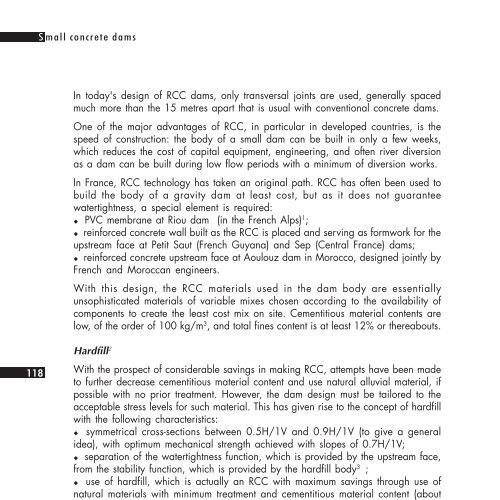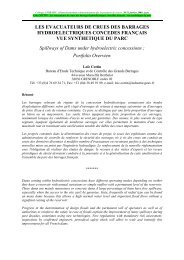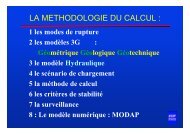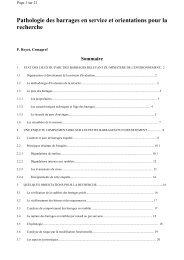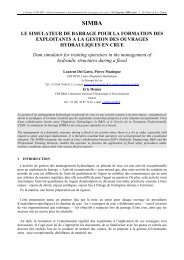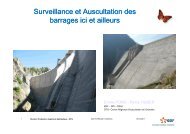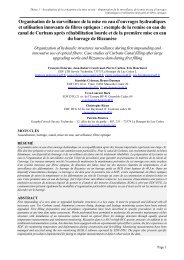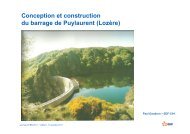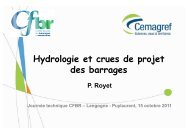SMALL DAMS
SMALL DAMS - Comité Français des Barrages et Réservoirs
SMALL DAMS - Comité Français des Barrages et Réservoirs
- No tags were found...
You also want an ePaper? Increase the reach of your titles
YUMPU automatically turns print PDFs into web optimized ePapers that Google loves.
S mall concrete dams<br />
In today's design of RCC dams, only transversal joints are used, generally spaced<br />
much more than the 15 metres apart that is usual with conventional concrete dams.<br />
One of the major advantages of RCC, in particular in developed countries, is the<br />
speed of construction: the body of a small dam can be built in only a few weeks,<br />
which reduces the cost of capital equipment, engineering, and often river diversion<br />
as a dam can be built during low flow periods with a minimum of diversion works.<br />
In France, RCC technology has taken an original path. RCC has often been used to<br />
build the body of a gravity dam at least cost, but as it does not guarantee<br />
watertightness, a special element is required:<br />
!"PVC membrane at Riou dam (in the French Alps) 1 ;<br />
!"reinforced concrete wall built as the RCC is placed and serving as formwork for the<br />
upstream face at Petit Saut (French Guyana) and Sep (Central France) dams;<br />
!"reinforced concrete upstream face at Aoulouz dam in Morocco, designed jointly by<br />
French and Moroccan engineers.<br />
With this design, the RCC materials used in the dam body are essentially<br />
unsophisticated materials of variable mixes chosen according to the availability of<br />
components to create the least cost mix on site. Cementitious material contents are<br />
low, of the order of 100 kg/m 3 , and total fines content is at least 12% or thereabouts.<br />
118<br />
Hardfill 2<br />
With the prospect of considerable savings in making RCC, attempts have been made<br />
to further decrease cementitious material content and use natural alluvial material, if<br />
possible with no prior treatment. However, the dam design must be tailored to the<br />
acceptable stress levels for such material. This has given rise to the concept of hardfill<br />
with the following characteristics:<br />
!" symmetrical cross-sections between 0.5H/1V and 0.9H/1V (to give a general<br />
idea), with optimum mechanical strength achieved with slopes of 0.7H/1V;<br />
!"separation of the watertightness function, which is provided by the upstream face,<br />
from the stability function, which is provided by the hardfill body 3 ;<br />
!" use of hardfill, which is actually an RCC with maximum savings through use of<br />
natural materials with minimum treatment and cementitious material content (about<br />
50 kg/m 3 ) ;<br />
!"a hardfill deformation modulus that can be estimated at a significantly lower level<br />
than that of CVC but that of course will depend on the nature and grading of the<br />
aggregate as well as the cementitious material content.<br />
The symmetrical cross-section transmits only low pressures to the foundation. With only<br />
dead weight, stresses are uniform at values approximately half of those under the<br />
upstream heel of a conventional gravity dam. Filling and operating the reservoir<br />
cause only slight changes in normal stresses and the entire concrete/foundation interface<br />
remains practically uniformly compressed.<br />
1. Photo 23, p. VIII.<br />
2. See Bibliography, reference 2, p. 139.<br />
3. For some dams, e.g. flood routing projects, the facing can be dispensed with.


